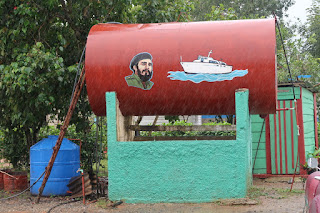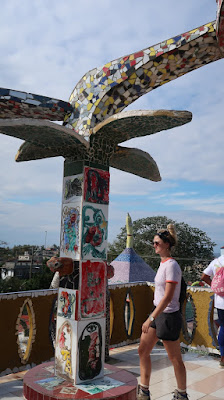Here are some final images taken from the hundreds on my camera. I've included text only when it seems necessary.
A wifi park in Havana, one of only a few we found where there is a public signal that you access by purchasing a card for $2.00 an hour. The signal is very weak so everyone clusters around the same area to get online.
The other option for tourists is to go to an expensive hotel and sit in the lobby. This only works if you have the right clothes and look like a tourist.
Havana street scenes




Young girls playing on the Prado after their dance class.


Musicians set up on sidewalks to collect tips.

A privately run palador where we had very good food. This one's on the Prado in Central Havana.


This woman and her child were hitching a ride--a common scene everywhere in Cuba.

An amazing mural in the Havana Museum of Contemporary Art

This mural of a boat was in the Revolution Museum. The boat is the one that Fidel and his crew crossed from Mexico to Cuba to start the revolution.

Scenes from smaller towns in the countryside.
All the children appear to have clean uniforms for school.


Here's the boat again. This is on a water tank in the tobacco growing area. All over Cuba you see signs and icons about the revolution.
This is a government store in Cienfuegos. There didn't appear to be much for sale. Most people purchase from street stands or on the black market I think.


It's possible that this is also a government store as it seemed quite established, but I'm not sure.

 We saw people lining up for bread and milk using ration cards but there are also places that sell food and flowers and vegetables and meat, often out of people's homes it appears.
We saw people lining up for bread and milk using ration cards but there are also places that sell food and flowers and vegetables and meat, often out of people's homes it appears.



Cuba is a complicated and fascinating country and we've been reading some books to try to discover more about it. One we liked was published in 2018 called "This is Cuba: an American journalist under Castro's shadow" by David Ariosto.
My next few blogs will be about the cities in Central Mexico that we visited in February.













































